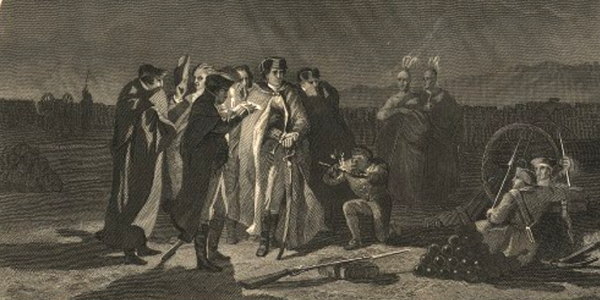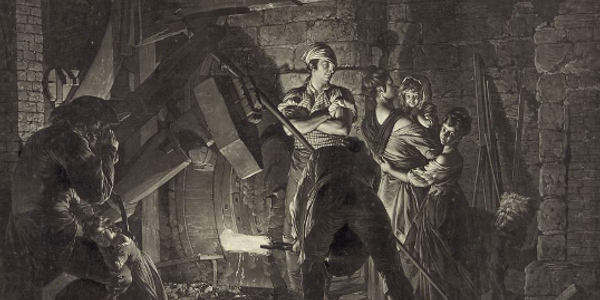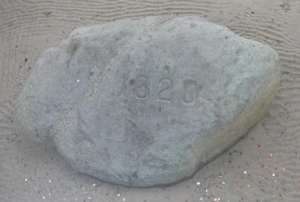Sponsor this page for $150 per year. Your banner or text ad can fill the space above.
Click here to Sponsor the page and how to reserve your ad.
-
Timeline
1754 Detail
July 3, 1754 - Battle of Fort Necessity occurs in southwestern Pennsylvania in a small fort built for supplies. That battle of the French and Indian War ends in a peace document, allowing Washington's withdrawal and surrender of the fort.

Colonel George Washington was a soldier commanding two hundred and ninety-three men of the Virginia Militia after the Battle at Jumonville in the western Laurel Mountains of Pennsylvania. The main battles of the French and Indian War were ahead. For now, his men needed protection, as well as one hundred men of the British Regulars from South Carolina under Captain John Mackay who would come as reinforcements, plus their few Indian allies, so a fort was built. It was small. More of a stockade than a defensible position, the small fort in the center of a large field, actually in the valley, was built of necessity, thus its name, but not a great place to fight from. The French were mad, and in no mood to allow Washington's troops to leave the area. They sent six hundred soldiers and one hundred Indians toward Fort Necessity. A battle ensued on July 3, 1754.
These first two battles had been coming for several years. Washington had been sent by the British to warn the French to leave the Ohio River Valley, which both nations saw as their territory for expansion west. The French disagreed and stayed with Washington returning to Virginia. In May 1754, Washington was charged with taking a group of Virginia soldiers west to build a road and defend a fort they had built near Pittsburgh, but unknown to the Colonel was that the fort had been siezed by the French. When Washington approached a French camp at what would become known as Jumonville Glen at dawn on May 27, a skirmish brewed, the Sieur de Jumonville, leader of the French, plus more than a dozen other French soldiers were killed or captured.
When the French troops arrived at Fort Necessity on July 3, they were incensed to revenge the deaths of their comrades, particularly due to their feeling that the surprise attack by Washington on what they termed a diplomatic mission was uncalled for. Colonel Washington had nine cannon in his defense, but when the French troops and their Indian allies attacked from the woods one hundred yards away, his fort could not withstand the barrage. Fighting continued throughout July 3 from morning until 8:00 p.m. The French, knowing by then that they had the upper hand, halted, and approached the fort seeking a truce and surrender.
Peace Agreement
Although some consider the end of the Battle of Fort Necessity as a peace agreement between three parties, it was actually a surrender to the French, what would be known as the Articles of Capitulation. Colonel Washington had lost, chosen a poor location for battle, and needed to find a way to end the conflict, even if it meant surrender and what was to the French an admittance that they had assasinated the French officer, the Sieur de Jumonville, at the previous battle. Washington did not agree with that context, and may not have known of its inclusion. Historians believe that when the original document, written in French, was translated for him by his aide that the word may have been skipped. Washington would sign the articles, knowing or unknowing, that fact lost in certainty to history. He would live, as well as the remainder of his men, to fight more battles in the French and Indian War, which would eventually lead to victory for his employer, the British. Washington thought he would be rebuked for his efforts when he returned to Virginia, but British authorities, including Governor Dinwiddie, thanked him. They blamed the loss on lack of support from the other colonies and insufficient supplies.
Today you can visit Fort Necessity National Historic Site in western Pennsylvania, see a reconstruction of the fort, take a ranger guided tour of the battle, and view exhibits and a film in the spacious Visitor center.

Full Text, Articles of Capitulation, Fort Necessity
Capitulation granted by Mons. De Villier, Captain of infantry and commander of troops of his most Christian Majesty, to those English troops actually in the fort of Necessity which was built on the lands of the King's dominions
July the 3rd, at eight o'clock at night, 1754.
Know ... As our intention had never been to trouble the peace and good harmony which reigns between the two friendly princes, but only to revenge the assassination which has been done on one of our officers, bearer of a summons, upon his party, as also to hinder any establishment on the lands of the dominions of the King, my master. Upon these considerations, we are willing to grant protection of favor, to all the English that are in the said fort, upon conditions hereafter mentioned.
Article 1 ... We grant the English commander to retire with all garrisons, to return peaceably into his own country, and we promise to hinder his receiving any insult from us French, and to restrain as much as shall be in our power the Savages that are with us.
Article 2 ... He shall be permitted to withdraw and to take with him whatever belongs to them except the artillery, which we reserve for ourselves.
Article 3 ... We grant them the honors of war; they shall come out with drums beating, and with a small piece of cannon, wishing to show by this means that we treat them as friends.
Article 4 ... As soon as these Articles are signed by both parties they shall take down the English flag.
Article 5 ... Tomorrow at daybreak a detachment of French shall receive the surrender of the garrison and take possession of the aforesaid fort.
Article 6 ... Since the English have scarcely any horses or oxen lift, they shall be allowed to hide their property, in order that they may return to seek for it after they shall have recovered their horses; for this purpose they shall be permitted to leave such number of troops as guards as they may think proper, under this condition that they give their word of honor that they will work on no establishment either in the surrounding country or beyond the Highlands during one year beginning from this day.
Article 7 ... Since the English have in their power an officer and two cadets, and, in general all the prisoners whom they took when assassinated Sieur de Jumonville they now promise to send them with an escort to Fort Duquesne, situated on Belle River, and to secure the safe performance of this treaty article, as was as of the treaty, Messrs. Jacob Van Braam and Robert Stobo, both Captains shall be delivered to us as hostages until the arrival of our French and Canadians herein before mentioned.
We on our part declare that we shall give an escort to send back in safety the two officers who promise us our French in two months and a half at the latest.
Made out in duplicate on one of the posts of our block-house the same day and year as before.
James Mackay
George Washington
Coulon de Villiers
Image above: Engraving of George Washington at the Night Council at Fort Necessity, 1855, John McNevin, Henry Bryan Hall. Courtesy Darlington Collection of Engravings at the University of Pittsburgh via Wikipedia Commons. Image Below: Visitor Center, Fort Necessity National Historic Site, 2014, America's Best History. Info Source: National Park Service; The Papers of George Washington, W. Abbot; Library of Congress; Wikipedia Commons.

History Photo Bomb

Colonel George Washington was a soldier commanding two hundred and ninety-three men of the Virginia Militia after the Battle at Jumonville in the western Laurel Mountains of Pennsylvania. The main battles of the French and Indian War were ahead. For now, his men needed protection, as well as one hundred men of the British Regulars from South Carolina under Captain John Mackay who would come as reinforcements, plus their few Indian allies, so a fort was built. It was small. More of a stockade than a defensible position, the small fort in the center of a large field, actually in the valley, was built of necessity, thus its name, but not a great place to fight from. The French were mad, and in no mood to allow Washington's troops to leave the area. They sent six hundred soldiers and one hundred Indians toward Fort Necessity. A battle ensued on July 3, 1754.
These first two battles had been coming for several years. Washington had been sent by the British to warn the French to leave the Ohio River Valley, which both nations saw as their territory for expansion west. The French disagreed and stayed with Washington returning to Virginia. In May 1754, Washington was charged with taking a group of Virginia soldiers west to build a road and defend a fort they had built near Pittsburgh, but unknown to the Colonel was that the fort had been siezed by the French. When Washington approached a French camp at what would become known as Jumonville Glen at dawn on May 27, a skirmish brewed, the Sieur de Jumonville, leader of the French, plus more than a dozen other French soldiers were killed or captured.
When the French troops arrived at Fort Necessity on July 3, they were incensed to revenge the deaths of their comrades, particularly due to their feeling that the surprise attack by Washington on what they termed a diplomatic mission was uncalled for. Colonel Washington had nine cannon in his defense, but when the French troops and their Indian allies attacked from the woods one hundred yards away, his fort could not withstand the barrage. Fighting continued throughout July 3 from morning until 8:00 p.m. The French, knowing by then that they had the upper hand, halted, and approached the fort seeking a truce and surrender.
Peace Agreement
Although some consider the end of the Battle of Fort Necessity as a peace agreement between three parties, it was actually a surrender to the French, what would be known as the Articles of Capitulation. Colonel Washington had lost, chosen a poor location for battle, and needed to find a way to end the conflict, even if it meant surrender and what was to the French an admittance that they had assasinated the French officer, the Sieur de Jumonville, at the previous battle. Washington did not agree with that context, and may not have known of its inclusion. Historians believe that when the original document, written in French, was translated for him by his aide that the word may have been skipped. Washington would sign the articles, knowing or unknowing, that fact lost in certainty to history. He would live, as well as the remainder of his men, to fight more battles in the French and Indian War, which would eventually lead to victory for his employer, the British. Washington thought he would be rebuked for his efforts when he returned to Virginia, but British authorities, including Governor Dinwiddie, thanked him. They blamed the loss on lack of support from the other colonies and insufficient supplies.
Today you can visit Fort Necessity National Historic Site in western Pennsylvania, see a reconstruction of the fort, take a ranger guided tour of the battle, and view exhibits and a film in the spacious Visitor center.

Full Text, Articles of Capitulation, Fort Necessity
Capitulation granted by Mons. De Villier, Captain of infantry and commander of troops of his most Christian Majesty, to those English troops actually in the fort of Necessity which was built on the lands of the King's dominions
July the 3rd, at eight o'clock at night, 1754.
Know ... As our intention had never been to trouble the peace and good harmony which reigns between the two friendly princes, but only to revenge the assassination which has been done on one of our officers, bearer of a summons, upon his party, as also to hinder any establishment on the lands of the dominions of the King, my master. Upon these considerations, we are willing to grant protection of favor, to all the English that are in the said fort, upon conditions hereafter mentioned.
Article 1 ... We grant the English commander to retire with all garrisons, to return peaceably into his own country, and we promise to hinder his receiving any insult from us French, and to restrain as much as shall be in our power the Savages that are with us.
Article 2 ... He shall be permitted to withdraw and to take with him whatever belongs to them except the artillery, which we reserve for ourselves.
Article 3 ... We grant them the honors of war; they shall come out with drums beating, and with a small piece of cannon, wishing to show by this means that we treat them as friends.
Article 4 ... As soon as these Articles are signed by both parties they shall take down the English flag.
Article 5 ... Tomorrow at daybreak a detachment of French shall receive the surrender of the garrison and take possession of the aforesaid fort.
Article 6 ... Since the English have scarcely any horses or oxen lift, they shall be allowed to hide their property, in order that they may return to seek for it after they shall have recovered their horses; for this purpose they shall be permitted to leave such number of troops as guards as they may think proper, under this condition that they give their word of honor that they will work on no establishment either in the surrounding country or beyond the Highlands during one year beginning from this day.
Article 7 ... Since the English have in their power an officer and two cadets, and, in general all the prisoners whom they took when assassinated Sieur de Jumonville they now promise to send them with an escort to Fort Duquesne, situated on Belle River, and to secure the safe performance of this treaty article, as was as of the treaty, Messrs. Jacob Van Braam and Robert Stobo, both Captains shall be delivered to us as hostages until the arrival of our French and Canadians herein before mentioned.
We on our part declare that we shall give an escort to send back in safety the two officers who promise us our French in two months and a half at the latest.
Made out in duplicate on one of the posts of our block-house the same day and year as before.
James Mackay
George Washington
Coulon de Villiers
Image above: Engraving of George Washington at the Night Council at Fort Necessity, 1855, John McNevin, Henry Bryan Hall. Courtesy Darlington Collection of Engravings at the University of Pittsburgh via Wikipedia Commons. Image Below: Visitor Center, Fort Necessity National Historic Site, 2014, America's Best History. Info Source: National Park Service; The Papers of George Washington, W. Abbot; Library of Congress; Wikipedia Commons.









